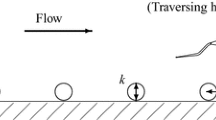Abstract
A possibility to simulate a thick Clauser-equilibrium incompressible turbulent boundary layer on a flat plate of finite length with the help of a grid formed by cylindrical rods was experimentally examined. A grid with rods oriented parallel to the streamlined surface proved to be an efficient tool enabling modification of the turbulent boundary layer. In most cases, at a distance of 600 rod diameters the time-average and fluctuation characteristics of the modified boundary layer exhibited values typical of a natural turbulent boundary layer. It is shown that the mean velocity profiles with artificially increased boundary-layer thickness can be represented, to a good accuracy, in terms of law-of-the-wall variables, and they can be generalized with a single dependence using an empirical velocity scale in the outside region. The use of a combined method for exerting an influence on the shear flow capable of improving the modeling procedure for turbulent velocity fluctuations in boundary layer is proposed.
Similar content being viewed by others
References
M. Schultz, M. Schatzmann, and B. Leitl, Effect of roughness inhomogeneities on the development of the urban boundary layer, Int. J. Environment and Pollution, 2005, Vol. 25, No. 1–4, P. 105–117.
L.J. Otten III and J.T. van Kuren, Artificial thickening of high subsonic Mach number boundary layers, AIAA J., 1976, Vol. 14, No. 11, P. 1528–1533.
P.H.A. Barbosa, M. Cataldi, and A.P.S. Freire, Wind tunnel simulation of atmospheric boundary layer flows, J. Brazilian Society of Mechanical Sciences, 2002, Vol. 24, No. 3, P. 177–185.
W.V. Burton, Wind tunnel simulation of an atmospheric boundary layer, Thesis in Mechanical Engineering, Texas Tech. University, 2001.
A.A. Kuraev and S.D. Salenko, Wind-tunnel modeling of the velocity distribution in near-ground boundary layer, Izv. SO AN SSSR, ser, Tekhn. Nauk, 1985, Iss. 3, No. 16, P. 110–114.
J.C.R. Hunt and H. Fernholz, Wind-tunnel simulation of the atmospheric boundary layer: A report on Euromech. 50, J. Fluid Mech., 1975, Vol. 70, Pt. 3, P. 543–559.
J.E. Sargison, G.J. Walker, V. Bond, and G. Chevalier, Experimental review of devices to artificially thicken wind-tunnel boundary layers, in: Proc. 15th Australian Fluid Mechanics Conf., University of Sydney, Sydney, Australia, 13–17 December, 2004.
W. Frank and H. Mauch, Aktuelle Probleme der Baumwerksaerodynamik, Stroemungsmechanik und Stroemungmaschinen, Verlag G, Braun Karlsruhe, 1989, Vol. 40, P. 81–97.
M. Sajben, J.C. Krouxil, G.H. Hoffman, and A.V. Sedrick, Generation of velocity profiles using screens of nonuniform solidity, AIAA J., 1975, Vol. 13, No. 4, P. 417–418.
J.L. Roberts and G.J. Walker, Artificial thickening of wind-tunnel boundary layers via an array of cross-flow jets, Experimental Thermal and Fluid Sci., 2003, Vol. 27, No. 2, P. 583–588.
S. Okamoto,, Turbulent shear flows behind two-dimensional obstacles placed on plane boundary, in: Proc. Symp. on Turbulence, Sept. 21–23, 1981, Rolla, MO, University of Missouri-Rolla, 1983, P. 9–14.
M. Arie, M. Kiya, Y. Suzuki, and I. Sakata, Artificial generation of thick turbulent boundary layers, Bulletin of the JSME, 1981, Vol. 24, No. 192, P. 956–964.
J.L. Carvalho and A.R.J. Borges, Interaction of a surface-mounted hot body with a turbulent boundary-layer, J. Wind Engineering and Industrial Aerodynamics, 1998, Vol. 74–76, P. 475–483.
A.V. Boiko and V.I. Kornilov, Hot-wire anemometer measurement of local skin-friction coefficient, Thermophysics and Aeromechanics, 2010, Vol. 17, No. 4, P. 577–586.
M.V. Zagarola and A.J. Smits, A new mean velocity scaling for turbulent boundary layers, in: Proc. of 1998 ASME Fluids Engineering Division Summer Meeting, June 21–25, 1998, Washington DC, P. 1–6.
L. Castillo and D.J. Walker, Effect of upstream conditions on the outer flow of turbulent boundary layers, AIAA J., 2002, Vol. 40, No. 7, P. 1292–1299.
V.I. Kornilov and A.V. Boiko, Efficiency of air microblowing through microperforated wall for flat plate drag reduction, AIAA J., 2012, Vol. 50, No. 3, P. 724–732.
T. Cebeci, Analysis of Turbulent Flows, Oxford, Elsevier Ltd, 2004.
Computation of Turbulent Boundary Layer, in: Proc. Stanford Conf. AFOSR-IFP, 1968-1969, Eds. D.E. Coles and E.A. Hirst, Stanford University, Vol. 2.
V.I. Kornilov and D.K. Mekler, Relaxation properties of a turbulent shear flow across a cylinder in the presence of a plate, J.Appl. Mech. Tech. Phys., 1990, Vol. 31, No. 6, P. 854–859.
J.F. Nash, Turbulent boundary layer behavior and the auxiliary equation, NPL Aeronautical Report, 1965, No. 1137.
V.I. Kornilov and Yu.A. Litvinenko, Skin friction measurement in an incompressible turbulent boundary layer. Part 1. Adverse pressure gradient, Thermophysics and Aeromechanics, 2001, Vol. 8, No. 4, P. 475–491.
V.I. Kornilov and Yu.A. Litvinenko, Skin friction measurement in an incompressible turbulent boundary layer. Part 2. Favorable pressure gradient, Thermophysics and Aeromechanics, 2002, Vol. 9, No. 2, P. 157–169.
Author information
Authors and Affiliations
Corresponding author
Rights and permissions
About this article
Cite this article
Kornilov, V.I., Boiko, A.V. Simulation of a thick turbulent boundary layer via a rod grid. Thermophys. Aeromech. 20, 289–302 (2013). https://doi.org/10.1134/S0869864313030049
Received:
Published:
Issue Date:
DOI: https://doi.org/10.1134/S0869864313030049




